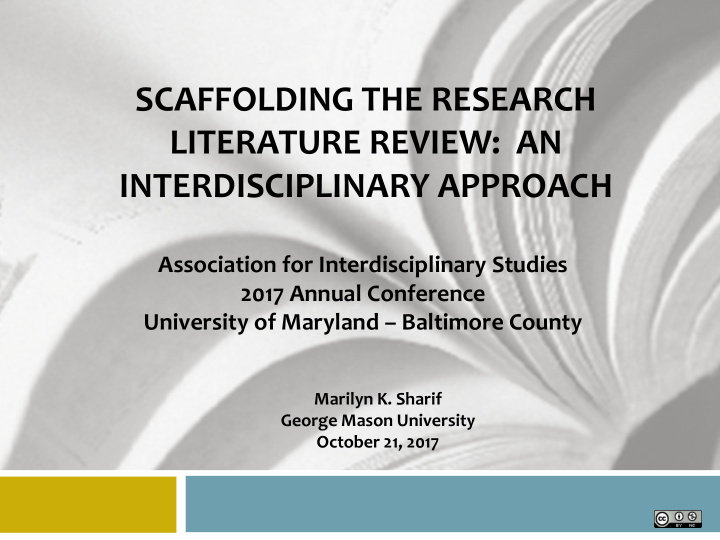



SCAFFOLDING THE RESEARCH LITERATURE REVIEW: AN INTERDISCIPLINARY APPROACH Association for Interdisciplinary Studies 2017 Annual Conference University of Maryland – Baltimore County Marilyn K. Sharif George Mason University October 21, 2017
Scaffolding the Research Literature Review Introduction to the Literature Matrix Description Goals Literature Matrix Assignment Learning Outcomes Instruction Steps Assessment Rubric Advantages of the Literature Matrix Student Examples of Literature Matrix Conclusion/Q&A
What is a Literature Matrix? MAIN QUESTION (Complex Problem or Issue to be Solved): ____________________________________________________________________________________________________________________________ ______ Table (or Excel Sub-question: (Discipline #1) ____________________________________________________________________________________________________________________________ ______ spreadsheet) Sub-question: (Discipline #2) ____________________________________________________________________________________________________________________________ Research Tool ______ Sub-question: (Discipline #3) Organization ____________________________________________________________________________________________________________________________ ______ Reflection I SAY* THEY SAY* Evaluation SOURCE MAIN POINT HYPOTHESES METHODS DATA DATA DATA CONCLUSIONS COMMENTS Author(s) and (Claim) THEORIES Sub-question Sub-question Sub-question (Analysis) Integration (Publication ASSUMPTIONS #1 #2 #3 Date) Source #1 Source #2 Source #3
Literature Matrix Assignment Add 3 relevant sources to the matrix 1. Develop corresponding list of references 2. using consistent citation format Participate in a matrix peer-review 3. workshop Revise/expand matrix and reference list 4. to 15 sources for instructor’s mid-term evaluation Revise/expand matrix and reference list 5. to scaffold the literature review Submit final matrix and reference list 6. with 25 sources one week prior to the final paper
Learning Outcomes of the Literature Matrix Assignment Fill out the matrix with relevant source information Use the matrix for reflection and evaluation of sources Identify gaps in the literature and make any necessary revision of questions Integrate information from the matrix to write a literature review
The Literature Matrix Worksheet MAIN QUESTION (Complex problem or Issue to be solved): __________________________________________________________________________________________________________________________________ Sub-question: (Discipline #1) __________________________________________________________________________________________________________________________________ Sub-question: (Discipline #2) __________________________________________________________________________________________________________________________________ Sub-question: (Discipline #3) __________________________________________________________________________________________________________________________________ THEY SAY* I SAY* METHODS CONCLUSIONS SOURCE MAIN POINT HYPOTHESES DATA DATA DATA COMMENTS Author(s) and (Claim) THEORIES Sub-question Sub-question Sub-question (Analysis) (Publication Date) ASSUMPTIONS #1 #2 #3 Source #1 Source #2 Source #3 Source #4 *For templates to scaffold academic writing see: G. Graff & C. Birkenstein (2014). They say, I say: The moves that matter in academic writing (3 rd ed.). NY: W.W. Norton & Company . Marilyn K. Sharif – BIS 390 2013; revised 2016; updated 2017 Bachelor of Individualized Studies Program, CHSS George Mason University, Fairfax, VA
Assessment Rubric for the Literature Matrix Assignment
Integration of the Research Disciplines Intersections of the circles represent integration of information and data across the matrix from the 2-3 sub- Sub-question questions that address the #1 main question (nexus) guiding the research literature review. Sub-question Sub-question #3 #2
Advantages of the Literature Matrix How does the literature matrix scaffold the learning process? Focuses the literature search Aids research reading and summarization skills Develops consistent citation format skills Helps avoid plagiarism Develops reflective and critical thinking skills Addresses challenges of integration and critical analysis in the literature review Helps identify gaps in the literature
Sample Student Matrices* Example #1 Example #2 Example #3 *Used with permission.
References Booth, W., Colomb, G. & Williams, J. M. (2008). The craft of research (3 rd ed.). Chicago, IL: University of Chicago Press. Graff, G. & Birkenstein, C. (2014). They say, I say: The moves that matter in academic writing (3 rd ed.). New York, NY: W.W. Norton & Company. Repko, A. (2005). Interdisciplinary practice: A student guide to research and writing (Preliminary edition). Boston, MA: Pearson Custom Publishing. Repko, A.F., Szostak, R. & Buchberger, M.P. (2014). Introduction to interdisciplinary studies . Washington, DC: Sage. Rosen, L. J. (2012). The academic writer’s handbook (3 rd ed.). Boston, MA: Longman/Pearson.
Questions/Discussions Contact information: msharif@gmu.edu
Recommend
More recommend